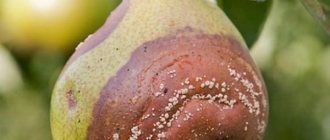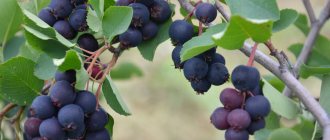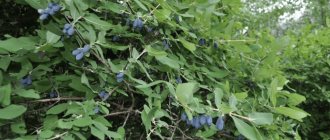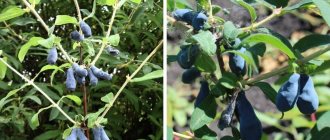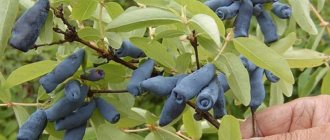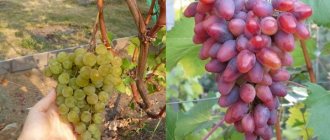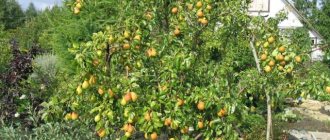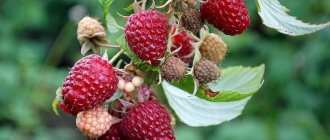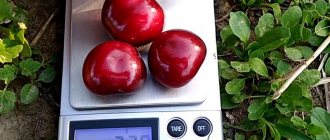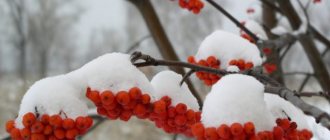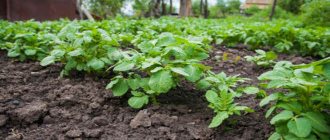Honeysuckle Cinderella is famous for its very tasty berries, excellent frost resistance and good resistance to diseases. Let's look at the features of growing this crop, and also see its pros and cons.
honeysuckle variety “Cinderella”
honeysuckle “Cinderella” is one of the magnificent varieties of early ripening crops
fast growth, excellent taste, pest resistance make the “Cinderella” variety a favorite
Features of fruiting
Cinderella berries usually ripen from June 15 to June 22. At the same time, they become ripe at different times, which forces them to harvest in several passes. However, approximately 90% of the fruit is harvested during the first harvest.
The first time berries appear on the bush is already 2-3 years after planting. Moreover, due to the fact that the bushes are quite short in stature, it is difficult to harvest using machinery. It is more convenient to do this manually.
For pollination, Cinderella definitely needs neighbors. For these purposes, you can use any honeysuckle seedlings of Kamchatka selection. And experts consider the following varieties to be the best pollinators:
- Azure;
- Gerda;
- Amphora;
- Memory of Gidzyuk;
- Tomsk;
- Kamchadalka;
- Parabelskaya;
- Leningrad giant.
Description and characteristics
The variety was obtained in 1974 by selecting seedlings from free pollination of the best Kamchatka honeysuckle No. 8 (Start). The breeding was carried out by specialists from the Siberian Research Institute of Horticulture named after. M. A. Lisavenko. The mark appeared in the State Register in 1991. Initially, the tolerance regions were East and West Siberian, Ural, now the variety is zoned across all regions of Russia.
The bush, unlike the Leningrad giant, is no higher than a meter with a dense, compact, spherical crown. The shoots are pubescent, thin, flexible, curved, olive. The leaves are dark green, large, elongated oval, slightly concave. The berries are from 0.7 to 2 g, elongated-cylindrical or almost spindle-shaped, blue-black with a thick waxy coating, the skin is dense, but not hard. The taste is very pleasant, soft, sour-sweet with a strawberry aroma. The chemical composition may vary depending on weather conditions, average values (per 100 g of product):
- sugar – from 8.3 to 8.8%;
- acids – from 0.9 to 1.6%;
- vitamin C from 20 to 28 mg;
- vitamin P from 560 to 600 mg;
- dry substances – within 1.15%.
Attention!
Cinderella develops normally and bears fruit well in temperate climates, but in areas with warm, short winters and hot summers, the yield is slightly reduced.
The bush enters the fruiting stage 3–4 years after planting. Honeysuckle Cinderella blooms in April or May (depending on the growing region), and the harvest is harvested in late spring or early summer. The berries ripen unevenly, and harvesting can take 5–12 days. Productivity from 1.3 to 5.8 kg per bush. The fruits are good fresh, suitable for preparing for the winter, preparing desserts, drying and freezing. Advantages of honeysuckle Cinderella:
- tasting score 4, 7–5 points;
- universal purpose of fruits;
- there is no bitterness or astringency in the berries;
- keeping quality (refrigerated for up to 2 weeks);
- early onset of fruiting and productivity;
- strong immunity to diseases and pests;
- an adult bush can withstand frosts down to 40–42°C even in snowless winters, and does not suffer from return frosts in the stages of bud opening, flowering and fruit filling.
The main disadvantage is self-sterility. To obtain a normal harvest, 2-3 shrubs of a different variety are planted next to Cinderella, blooming in the same period. All seedlings and selected forms of Kamchatka honeysuckle are suitable. The disadvantages include partial shedding (up to 3 points) of fully ripened berries, so that the carrion does not deteriorate, an oilcloth/film is spread under the bush.
Pros and cons of the variety
Cinderella is a honeysuckle that has the following advantages:
- excellent tolerance to low temperatures;
- good resistance to various diseases;
- high yield with proper care;
- early ripening of berries;
- great taste;
- the ability to use shrubs as a decorative element to decorate the yard.
Cons of Cinderella:
- the need to plant varieties for pollination;
- possible shedding of ripened fruits;
- the likelihood of berries ripening at different times;
- inconvenient use of harvesting equipment.
Advantages and disadvantages of the variety
Pros of Honeysuckle Cinderella:
- frost resistance;
- high yield with proper care;
- disease resistance;
- early maturation;
- excellent taste;
- decorative type of shrub.
Disadvantages of the variety:
- need for pollinating varieties;
- tendency to shed berries;
- uneven ripening of fruits;
- difficulties with harvesting when using technology.
Difference from other varieties and hybrids
A comparison of Cinderella with other honeysuckle varieties is presented in the table.
| Variety/hybrid | Ripening period | Average weight of berries, g | Taste | Berries shape | Productivity, c/ha |
| Cinderella | Early | 1-1,4 | Sweet with sourness | Oval-elongated, elongated or fusiform | 10,5 |
| Ivushka | Average | 0,75 | Sweet and sour with bitterness | Fusiform | 50 |
| Kamchadalka | Early | 0,8 | Sweet and sour | Extended | 31 |
| The Giant's Daughter | Mid-late | 1,8-2,5 | Sweet and sour | Elongated teardrop-shaped | 69,4 |
| Krasnoyarochka | Average | 0,62 | Sweet and sour | Capsicum | 33,2 |
Selection of seedlings
In order for the crop to grow and delight you with the harvest, choose the right seedlings:
- ideally they should be 2-3 years old;
- the leaves should have a healthy shine with gloss and no damage;
- the plant must be healthy, without traces of diseases;
- branches of seedlings should be alive and flexible, and not dry or broken;
- give preference to potted seedlings rather than bare-rooted ones;
- be sure to purchase varieties for pollination.
Landing Features
When planting, you must adhere to the deadlines and choose the right planting site. It is also important to properly prepare the holes and planting material.
Deadlines
Honeysuckle variety Cinderella is planted in the fall after the end of the growing season. Spring planting is also acceptable during the period when the snow has already melted and sap flow has not yet begun.
Selecting a site, preparing holes
To plant honeysuckle Cinderella, choose a site:
- open to sunlight;
- protected from sharp gusts of wind;
- pH 6.5–7.
To plant, it is not enough to simply dig holes.
Planting holes should be prepared as follows:
- Dig a hole 0.4 m deep and wide, separating the top and bottom layers of soil.
- Mix the top layer of substrate with 10 kg of compost and 1 liter of ash.
- Pour the resulting fertile soil mixture into the planting hole.
Selection and preparation of planting material
Careful selection of seedlings will help avoid further problems in cultivation.
The following parameters indicate the quality of planting material:
- age 2–3 years;
- closed root system;
- shiny leaves;
- whole shoots.
Before planting, the plant is checked for integrity and damaged areas, if any, are removed. Purchasing a seedling with an open root system is also allowed, but in this case the rhizome should be treated with a solution of the Epin drug for half an hour.
Landing technology
Seedlings need to be planted using the technology indicated below:
- Fill the planting hole with water.
- Place the seedling in the hole.
- Fill the free space with the bottom layer of excavated soil.
After planting, water the bush thoroughly.
Landing instructions
How to plant Cinderella:
- dig planting holes at a distance of 1.5-2 m from each other - their dimensions should be about 40 cm;
- mix the top layer of excavated soil with a bucket of humus or compost and 1 liter of wood ash - if the soil itself is of heavy consistency, add a little sand;
- pour this mixture back into the planting hole by about a third;
- water the substrate in the hole;
- remove the seedling from the container where it was, along with a lump of earth - if it had bare roots, carefully straighten its roots and soak for half an hour in a solution of water and “Epin” or “Kornevin”;
- in the middle of the hole, make a depression suitable for the volume of the roots of the seedling, and plant the plant in it;
- add nutrient soil and compact the hole;
- Water the plantings generously with warm water.
During planting, remember that the root collar of the seedling cannot be buried (it should remain approximately 1 cm from the surface). Also plant pollinating varieties at the same time as Cinderella. Otherwise, you won’t be able to enjoy the fruits of the plant.
Tips and reviews from experienced gardeners about the variety
Experienced gardeners recommend:
- use ash infusion to spray bushes - it serves to prevent the development of diseases and insect attacks;
- When preparing the site, pour boiling water and potassium permanganate onto the soil - this will help get rid of rodents and kill pathogenic flora.
Gardeners speak positively about the Cinderella variety:
Alexey, Nizhny Novgorod: “My father began to grow edible honeysuckle on the plot. He started with Cinderella, then tried several more varieties, but in the end he liked Cinderella more, although other varieties produced larger fruits. The fact is that there are always more berries on the Cinderella bushes and they taste wonderful - very sweet with a slight sourness and strawberry aroma.”
Maria, Perm: “I love the Cinderella variety for its productivity and unpretentiousness. There are not very many berries, because there is only one pollinating bush nearby, but we have enough. And we grow this honeysuckle not so much for its fruits, but as a hedge - the bushes are very beautiful, they decorate the area.”
Care measures
Any honeysuckle needs high-quality and competent care. The productivity of the plant and its development directly depend on this. Water the crop in a timely manner, fertilize it and trim the foliage of the bush in a timely manner.
In the video below, the gardener talks about caring for honeysuckle “Cinderella”:
Read the article on how to care for honeysuckle in the fall.
Watering
In the first year of life, Cinderella bushes require special moisture. If the weather is particularly dry and hot, water the plant once every 7 days. The watering portion should be 2 buckets of water per bush. After each moistening, carefully loosen the soil, remembering the roots located close to the surface.
When the bushes enter the phase of ovary and fruit ripening, water them even more abundantly. Now pour 8 to 10 liters of water under each bush. If there is not enough moisture for the crop, this will affect the bitter taste of the berries.
After harvesting the fruits, honeysuckle no longer needs such abundant and frequent moisture. When the optimal amount of rain falls, reduce watering to 3-4 times per season.
Feeding honeysuckle
Start feeding honeysuckle in the third year of its life. Until then, the funds contributed during planting are enough for her. The fertilizer application regime is as follows:
- feed the crop for the first time in the spring before the buds open, with a urea solution (1 tbsp per bucket of water);
- Twice a season, feed the plant with chicken droppings, diluted in the proportion of 1 glass per bucket of water and infused for 1-2 days - water the bushes at the roots in the evening, before the crop blooms and after harvesting the fruits;
- in mid-summer, after picking berries, pour Cinderella with a solution of nitroammophoska (25-30 g per 10 liters of water);
- Sometime in July, add to the soil or spray the honeysuckle with a solution of 100-150 g of ash mixed in a bucket of water (stir the ash until it is completely dissolved in the liquid).
Pruning and its types
Honeysuckle variety Cinderella needs crown formation. This is necessary to increase the productivity of the bush and its attractive appearance. Especially if the plant is used as a decorative element of the yard.
Types of pruning:
- primary - carried out immediately after planting, in which all weak, non-viable branches are removed (leave 3-5 of the strongest shoots, reducing them by a third);
- sanitary – involves annual pruning of dry, damaged and disease-affected branches;
- rejuvenating - done in the 7th year of the plant’s life (cut off all the old branches in the fall, in the place of which new ones will grow).
Features of cultivation
Due to the early start of the growing season in regions with temperate and cool climates, Cinderella is planted only in the fall; in warm areas, planting is permissible from early October to mid-November. The pit is prepared 3–5 days before planting. Leave 1.5–2 m between honeysuckle bushes. The width of the hole should be about 40–50 cm, and the depth should be calculated independently (depending on the size of the root). Landing:
- a 15 cm layer of broken stone or gravel is placed at the bottom of the hole, and the same layer of a mixture of garden soil and rotted cow manure (2:1) with the addition of 500 g of wood ash is poured on top;
- a seedling is placed in the middle of the hole, the roots are straightened and covered with the remains of the soil mixture, so that the root collar remains on the surface;
- An earthen ditch is made around the main trunk, at a distance of 30–60 cm, 20–40 liters of water are poured under the seedling, the trunk circle is mulched with rotted sawdust, peat, dry grass or fallen leaves (layer 7–10 cm).
Attention! If the seedling's root is covered with film, only a lump of earth is left when planting, and if it is wrapped in decomposed material, it is planted as is.
The roots of a weakened or very young seedling are placed in a solution of Epin or Zircon a couple of hours before planting. Water the bushes only with warm water, gradually, allowing the water to be absorbed. It is not advisable to immediately trim or shorten branches; this may negatively affect the further development of honeysuckle; in extreme cases, you can remove damaged or dry shoots. The first month after planting, water once a week (a bucket of water per bush). We describe the care features in the table.
| Procedure | Description |
| Watering | In normal weather, the shrub does not need additional moisture, and in drought it is watered regularly, but moderately (a bucket at a time), so that the moisture does not evaporate quickly, the tree trunk circle is mulched. After watering and rain, the earth is loosened, but carefully and shallowly; honeysuckle has a superficial root |
| Nutrition | No fertilizing is needed before the first flowering, then fertilizers are applied 3-4 times throughout the growing season. Before flowering and immediately after harvesting the entire crop, use chicken manure (a glass per 10 liters of water, half a bucket per bush). At the end of July, humic fertilizer or a balanced mineral mixture is taken, the solutions are prepared and used according to the instructions. In late autumn, 500–600 g of wood ash are scattered in the tree trunk circle. |
| Trimming | For the first few years, only damaged, weak, and dry branches that thicken the crown are removed; any pruning is planned for early spring or autumn (after leaf fall). When the bush is 10–12 years old, the yield begins to gradually fall, rejuvenating pruning is carried out to restore it, and all old branches are removed in the fall. In spring, honeysuckle will grow many new shoots |
| Preparing for winter | For the first 2 years after planting, leaves are raked up to the bush (covering the branches half their length), then completely covered with snow. In the future, Cinderella will winter well without insulation. |
| Prevention | For additional protection from diseases and pests, all varieties of honeysuckle growing in the garden are sprayed with biological insecticides and fungicides 3-4 times per season. |
Attention! Cinderella produces little root growth, new shoots are cut off immediately upon regrowth, and no stumps are left.
Most often, Cinderella is propagated by green cuttings in spring or early summer. Rooting rate with this method is about 95–98%. From a young, non-lignified branch, cut a cutting up to 20 cm in length, immerse it entirely in clean water for 2-3 hours, then dig it in the garden (bury the lower part by 2/3 of the length). Rooting the cuttings also gives good results: the lower branch is tilted to the ground, fixed with a bracket and sprinkled with a mixture of sand and soil. After the roots appear, the stem is cut off from the mother bush and planted in a new place.
Tips for growing grapes
Honeysuckle Blue spindle: planting and caring for the variety
Honeysuckle Nymph - how to plant and grow on your site
Honeysuckle Kamchadalka: description of the variety and cultivation characteristics
Honeysuckle Cinderella begins to bear fruit abundantly from the age of 5 or 6. If you plant a shrub in a sunny, windless area with loose, non-acidic soil and properly care for it, you can achieve record results - 5, and sometimes up to 6 kg of berries. Compact, neat and low bushes can be used to decorate flower beds, flower beds, paths, fences and driveways.
Reproduction methods
You can propagate Cinderella in two ways:
- By cuttings. Take a cutting of a young branch and keep it in a container of water for several hours. Then bury the shoot at an angle 2/3 of its size.
- By layering. To propagate honeysuckle in this way, dig in the bottom branch of the bush, securing it to the ground with a staple.
Reproduction
Green cuttings are the most effective way to propagate honeysuckle, in which about half of the planting material takes root. Procedure:
- Separate from the mother plant a branch of annual growth 20-40 cm long with a piece of cambium.
- Place the cuttings in a solution of a growth stimulator (Heteroauxin, Kornevin) for 12-16 hours.
- Plant it in a garden bed in a mixture of peat and perlite at an angle of 45°.
Another method of propagation is air layering. To do this, select a suitable side shoot, tilt it, fix it and sprinkle it with earth. With regular watering, roots and sprouts form in the internodes. In the spring, the cuttings are separated from the mother bush and transplanted to a prepared area.
Reference. The seed propagation method is rarely used, since it does not guarantee the preservation of varietal characteristics.
Harvesting honeysuckle
You can collect Cinderella fruits throughout the first month of summer. The decades of berry ripening depend on the growing region, growing conditions and climate. Most often, honeysuckle fruits are harvested in the first half of June.
Cinderella differs from other varieties in that its berries ripen rather unevenly. This means that the harvest will have to be done in several stages (usually two). Do not keep ripe fruits on the bush for a long time, otherwise they may fall off. When picking berries, place some cloth under the plant to collect the fruits that fall during the picking process.
Botanical portrait
Honeysuckle variety Cinderella is a low-growing bush with thin curved branches and small leaves of a light green hue. The variety is distinguished by early fruiting. Already in the 3rd year it begins to bear fruit. The yield of Cinderella is relatively low, only 1.7 kg per bush, but this disadvantage is compensated by the harmonious taste of the berries with a slight sourness and pleasant strawberry aroma, as well as excellent winter hardiness and resistance to common ailments.
Cinderella berries are large, their length reaches 1.5 cm, and their weight is 1–1.4 g
Cinderella berries are large, their length reaches 1.5 cm, and their weight is 1–1.4 g. The shape of the fruit is elongated, and the thin skin has an almost black color and a bluish coating.
The variety is self-sterile. In order for Cinderella to bestow her fruits on you, you need to plant several pollinating varieties on the site. As stated by the authors, any varieties of Kamchatka honeysuckle are suitable for pollination, but experienced gardeners believe that the following varieties will be the best neighbors for Cinderella:
- Leningrad giant;
- Blue spindle;
- Amphora;
- Kamchadalka;
- Tomsk
Photo gallery: pollinating varieties for honeysuckle Cinderella
Table: advantages and disadvantages of the variety
- excellent winter hardiness;
- disease resistance;
- pleasant berry taste.
- tendency to shed ripe berries;
- self-sterility (it is necessary to plant several bushes of different varieties on the site);
- uneven ripening of fruits.
Video: Honeysuckle Cinderella
Diseases and pests
Cinderella rarely gets sick, but it does happen. One of the main signs of a plant becoming infected with a viral or fungal infection is the appearance of various spots on the bush.
Diseases that can affect honeysuckle:
- Powdery mildew. To combat this disease, use a solution of copper sulfate, tobacco dust and soap.
- Moniliosis. This infectious disease causes the plant to wither and can spread throughout the entire bush. If the honeysuckle is in the initial stage of the disease, prune the infected branches and then treat them with a preparation that contains copper. As a preventive measure, treat the crop with Fitolavin.
- Cercospora blight. The manifestation of this disease is expressed in the formation of dark green spots, which over time can acquire a brown tint with a dark outline. To combat the disease, thin out shoots and remove infected foliage. For prevention, spray the shrub in the fall and early spring with Fitolavin.
The main parasites for honeysuckle are mites, aphids, nematodes, glass beetles and moths. Fight them by cutting and destroying the affected parts of the crop. For prevention, use special chemicals.
Botanical description
Honeysuckle Malvina is represented by vigorous bushes, one and a half meters high. The crown of the plant is thick, squat, oval in shape. The skeletal branches are relatively thin and dark brown in color. The remaining shoots are light green, thin, erect, with slight pubescence on the surface of the bark. The dark green leaf blades of honeysuckle are large, dense, elongated-oval in shape with a point at the top.
The elongated pear-shaped berries of the variety are large, 2.9 cm long and weighing 1.1 g. Their bluish-blue surface is slightly tuberculate, without pubescence and with a slightly elongated base (a small uneven ridge is noticeable at the top). Under the dense skin with an intense waxy coating is hidden a fibrous pulp with a pleasant sweet and sour dessert taste. Its tasting score is 4.4 points.
Reviews of honeysuckle Cinderella
★★★★★
Irina, 42 years old, cashier, Omsk. I really like this variety for its taste - moderately sour, moderately sweet, not bitter.
At the same time, the bush itself is compact and does not take up much space. True, the berries are small, especially compared to Morena. ★★★★★
Igor, 50 years old, worker, Vladimir. I live in Vladimir and concluded that this variety is not suitable for our region.
I don’t know, maybe I’m doing something wrong, but the tips of the branches constantly dry out. It feels like the bush is missing something. I didn't like the taste, it was bitter. ★★★★★
Elena, 46 years old, doctor, Novokuznetsk. I planted Cinderella in my dacha.
It has taken root well, but it doesn’t produce very many berries yet, although the bushes are already 5 years old. It tolerates frost well and is a very tenacious plant. The truth is that they ripen unevenly, you have to keep watch, otherwise they crumble. The berries taste pleasant, but more sour than sweet. Hide
Add your review
Honeysuckle Cinderella is an excellent shrub for growing in regions with cold climates. It is not afraid of frost, ripens early and has a pleasant taste. Follow the recommendations and properly care for the variety to enjoy aromatic berries in early summer.
0
0
Copy link
Cinderella
Among honeysuckle varieties, Cinderella is classified as a mid-early variety. It belongs to the Kamchatka species of honeysuckle. It is distinguished by its winter hardiness and is suitable for cultivation in the coldest regions. The variety was created by free pollination of Kamchatka honeysuckle and selection of seedlings.
This variety is considered universal for its purpose. Cinderella berries have an attractive sweet and sour taste with a unique strawberry flavor. The plant reveals its potential with good timely watering and high-quality cross-pollination. The bush blooms in mid-to-late May; Cinderella is considered a good honey plant.
Description of the variety “Cinderella”
If we look at the botanical portrait of this variety of honeysuckle, we can say the following:
- the plant looks like a medium-sized bush with curved branches;
- the leaves are quite small and have a light green tint;
- the berries of the bush have a strawberry taste with a slight sourness, up to 1.5 cm in length, weighing 1-1.5 g. They have an elongated shape, thin black skin with a bluish coating;
- fruiting of the plant begins in the third year of life;
It cannot be said that honeysuckle is super productive, but it has other advantages: the berries have a harmonious and pleasant taste. Regarding diseases, we can safely say that they largely bypass “Cinderella”.
In addition, the shrub overwinters well in harsh winter conditions and quickly recovers in the spring.
In order for the plant to be pollinated safely, it is necessary to plant several bushes at once, since the variety is self-sterile.
The authors claim that in order for pollination to occur, any type of Kamchatka honeysuckle is necessary, but in practice there are other results: gardeners with experience claim that for a good neighborhood for “Cinderella” varieties would be ideal in the form of: Leningrad Giant, Blue Spindle, Kamchadalka, Tomsk, Amphoras.
So, let's summarize some of the results:
- The undoubted “advantages” of the plant include its high winter hardiness, the variety perfectly resists many diseases, and honeysuckle berries have excellent taste.
- Among the disadvantages, one can note: it is itself sterile, so several bushes - pollinators should be planted on the site at once, “Cinderella” is prone to shedding during the ripening period of the berries, the fruits ripen unevenly.
Despite the significant disadvantages, many gardeners prefer to grow this particular variety of shrub, as they believe that the positive qualities of the plant outweigh all its negative aspects.
Brief history of the variety's creation
This variety of honeysuckle got its name not by chance; scientists named it for the diligence with which Cinderella produces her fragrant and tasty berries. This variety belongs to the Kamchatka honeysuckle species, which is considered the most winter-hardy and unpretentious of all berry crops.
Honeysuckle variety Cinderella has gracefully curved branches, decorated with dark fruits with a bluish coating
Cinderella was obtained as a result of free pollination of Kamchatka honeysuckle at the Scientific Research Institute of Horticulture of Siberia named after. Lisavenko in Barnaul. The authors of the variety are Z.I. Archer, I.P. Kalinin and Z.P. Zholobova. Honeysuckle Cinderella has been subject to state variety testing since 1983, and was included in the State Register of Breeding Achievements of the Russian Federation in 1991 and recommended for cultivation in Western and Eastern Siberia, as well as in the Urals.
Honeysuckle “Cinderella” - planting a useful crop and its varietal characteristics
Honeysuckle is a unique crop, but for some reason not everyone grows it in their dacha. Meanwhile, the fruits of the bush have a rich composition and, if consumed regularly, can significantly improve health. Moreover, they are low-calorie and help reduce weight, but there’s no need to talk about the positive effect on the immune system - it’s colossal. We hope you are interested, but today we will talk about a very good variety and give recommendations for its cultivation. The theme is honeysuckle “Cinderella”.
How the variety was created
Honeysuckle “Cinderella” comes from the Scientific Research Institute of Horticulture of Siberia named after. Lisavenko, which is located in the city of Barnaul. Thanks to the works of scientists Linchuk Z.I., Kalinina I.P., Zholobova Z.P. a variety has appeared with many advantages.
“Cinderella” is the result of many days of work and the result of free pollination of Kamchatka honeysuckle.
Many years of scientific testing passed before honeysuckle was included in the State Register, and this happened in 1991. Thanks to its varietal characteristics, “Cinderella” has become widely used and has become one of the most common crops among gardeners in Siberia and the Urals.
Fruiting
Honeysuckle begins to bear fruit quite early; it is one of the earliest berry bushes. Since the variety is prone to fruit shedding, place non-woven material under the bush, this way you will better protect the harvest.
“Cinderella” is a universal honeysuckle, it dries well and is used as an additive to tea, it is frozen for the winter, jam is made from it and compotes and jams are prepared. The berries contain vitamins and microelements; they are used for many diseases and serve as an excellent preventive measure.
Sources:
https://sortoved.ru/zhimolost/sort-zhimolosti-zolushka.html https://mirogorodov.ru/zhimolost-zolushka.html https://sornyakov.net/trees/zhimolost-zolushka.html
